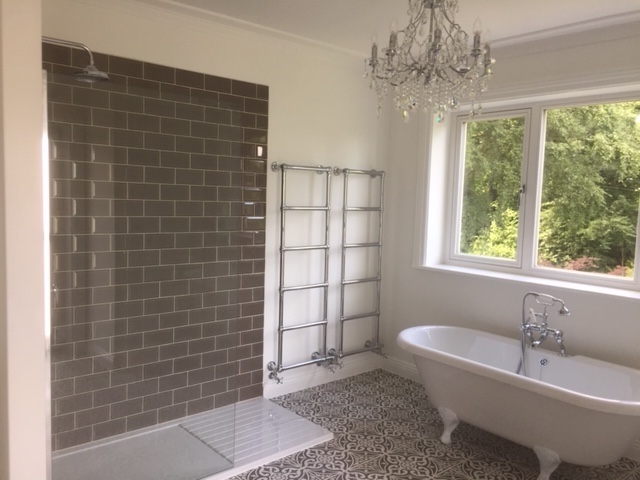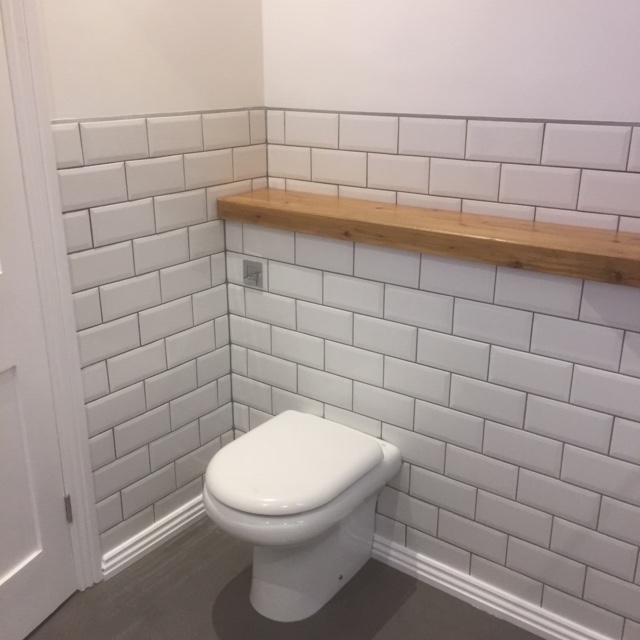
The game consists of organising the artefacts against the available wall space in such a way that you can: a) open the door, b) sit on the loo without burning your legs, c) get children in and out of the bath, d) reach the towels and take a shower and get dry easily. Bonus points are awarded for designs where: there is no visible pipework (though of course pipework should be accessible in case of leaks), the towel radiator can be reached from the shower tray, the mirror is lined up over the wash hand basin, you can turn the shower on and off without getting wet, and there is storage space for towels, toilet rolls and sundry other trappings of contemporary sanitary life.

It’s a hazard of my occupation that I have to play this game endlessly all year round and I’ve not been offered a mince pie yet! Anyway, here are some tips from a sad old hand.
Firstly, don’t try and do the exercise solely on paper. A plan helps but you do need to actually get in to the space and see how it works. Architects never produce good bathroom layouts on plans. Ideally, get the artefacts in the room and try and set them out. The bath, pan and basin are only thigh high so you don’t actually need as much floor space to move around and appears on a plan drawing.
Secondly, use space under windows and behind doors. If the window board is high enough then the pan can go under the window. It may be possible to take out the internal brickwork under the window and place a hidden cistern inside the wall under the window board. Likewise, a counter top bowel and tap can be plumbed in on a wide window board though this means you can’t have a mirror above the basin.
Towel radiators can often go behind doors if there is a 100mm or so of clearance. Alternatively, it’s often worth exploring whether doors can be rehung to open outwards. I’ve often done this in traditional narrow WC where clients have wanted to install a wash hand basin
Where possible I always try and get towel rails within reach of the shower tray so that warm towels can be grabbed without getting the floor wet.
Thirdly, don’t be afraid to use boxing to hide pipework but try and leave it high level so it looks like you actually did it to create shelf space. Low level boxing to conceal water or soil pipes can look like… well, low level boxing to conceal water or soil pipes and you don’t want anything that vulgar in your ouvre d’art sanitaire. Boxing in at around a metre high looks chic and can be used to conceal cisterns and create alcoves and niches in which expensive bottles of soap can be casually stood.

Now as a reward for reading this far I’m going to tell you something that could save you money. You don’t need to spend hundreds of pounds on polished marble, granite or slate. If you’ve got any Yorkshire paving stones knocking around, these can be cut down to make really cool tops in bathrooms. They don’t have to be long lengths as you can join pieces and point the join with mortar or grout. If you haven’t got any handy slabs you can buy Indian stone imitation paving that looks good and costs a fraction of the cost of Yorkshire stone. Or, if you are anywhere near North Wales or the Lake District go to a working slate quarry and pick up some reject slabs of cut slate. These can be cut with a grinder and make stunning tops.
Now, one of the beauties of boxing in is that you often don’t need to have the shower valve below or anywhere near the shower head. A hidden valve can be mounted at the other end of the shower or bath or even outside the shower enclosure altogether. This has the real advantage that you can turn the water on and off without getting your arm wet.
Lastly, a word on lines. There are two types of bathroom: in one everything is centred and lights, tiles and artefacts and fans line up; in the other, people sit on the loo and fret. It doesn’t matter how much you spend on artefacts and tiles, if things don’t line up the finished look will forever be tarnished.
So, when you’ve laid out the artefacts and got the spacing how you want it then set out the lights. If inset downlights are going to be installed I try and get them centred on the artefacts, so have one dead centre to the pan, shower, bath and basin. This will have the advantage that anyone reading in the bath or on the loo will have good light. The fan should also be centred close to the shower head so that way anyone looking up sees shower head, light and fan dead in line.

Setting out tiling can be very time consuming and exasperating. It’s well worth persisting, however, good setting out makes tiling easier and quicker and there’s nothing as satisfying as sitting on the loo or lying the bath and seeing how the tiles line up perfectly from the floor to the wall, centred exactly on the valve which in turn is centred on a niche which is perfectly plum with the light above it; pure bliss!
Alternatively, you could just play charades.











